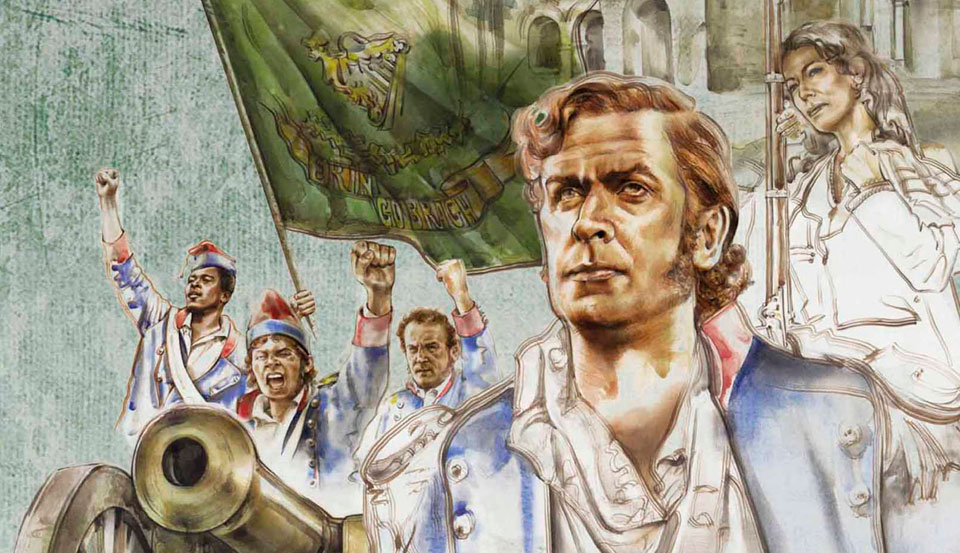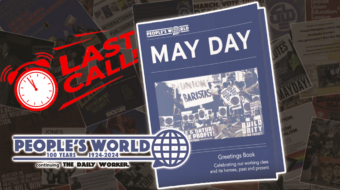
September 12 in Mexico is an official holiday, made so to honor those fighters who gave their lives in the struggle for national sovereignty for that nation, against great power arrogance and aggression. It is appropriate for a progressive publication to bring to light, and honor, those heroic Irish fighters of the St. Patrick’s Battalion, known in Spanish as the “San Patricios.”
In what we were taught was the Mexican War (1846-48), the U.S. invaded Mexico, seizing 1/3 of her national territory, what is today the U.S. states of Arizona, California, Utah, Nevada, New Mexico, parts of Colorado and Wyoming. The independent Republic of Texas was annexed just before the start of the war. While official history paints a story of “heroic” settlers fighting for “freedom” from Mexico, the reality was much different.
The Irish immigrants who gave their all saw that fight far differently, as one very similar to their homeland, one that saw raw arrogant imperial power seizing homes, lands, property of another, smaller, weaker nation of Catholic working people. While many immigrant soldiers abandoned their posts and others grumbled but made their peace, hundreds of Irish immigrants from tyranny said that they could run no further. Probably knowing their ultimate fate was not a good one, they chose to desert from the U.S. Army and fight injustice in a struggle that they saw as much like the one they had just left in their beloved but occupied homeland.
They called themselves the St. Patrick’s Battalion and they fought that war on the side of those being invaded, under a green flag emblazoned with “Eirinn Go Brach”—“Ireland Forever” or “Ireland ’Til the End of Time.” Even as this long-suppressed story has begun to be rediscovered, it is still little known that some of those fighters were German immigrants, democratic-minded and strongly opposed to slavery.
Their leader was a man from County Galway, Sean O Raghailligh (John Riley, when he landed here). He had been impressed into the British Army and taught the skill of an advanced artilleryman. Connemara, his home, was one of the worst hit by the British colonial-imposed Great Famine, and he was forced to emigrate. If the British Army were arrogant imperial thugs, enforcing John Bull’s will on other people and nations, they were certainly very good at teaching the use of artillery to those forced into their army. John Riley used that skill well!
The buildup to that war/invasion was wracked by an ever-increasing battle on the homefront on the issue of slavery. A rising abolition movement, along with a building free soil movement, strongly opposed any expansion of slavery. Slaveholders, meanwhile, looked toward Cuba, Mexico, and other areas to conquer so that territory open to slavery could be expanded. In that situation, slaveholders began sending settlers into Mexican territories, bringing slaves with them. Mexico, however, had abolished slavery in 1829. If slavery could be expanded into those areas, an imperial war would have to be launched to re-impose it on Mexico.
A manufactured dispute did just that in 1846, and the army was sent to crush that nation, seize its lands, and declare slavery again legal. However, it was a horribly unpopular war; much like Vietnam later, it sparked wide protests. Lincoln spoke out against it; demonstrations in the U.S., Ireland, and Britain were organized against the war.
Ulysses S. Grant, who served in that war, stated, “I do not think there was ever a more wicked war than that waged by the United States on Mexico. I thought so at the time, yet I lacked the moral courage to resign.” Henry David Thoreau’s famous refusal to pay war taxes took place during this infamous time.
This was the situation in which thousands of Irish men and women, fleeing British-imposed famine and colonial oppression, came to the United States.
Swept into the army, as a way to merely survive, these immigrants found themselves in an invading army supporting slavery, facing poor Catholic working people with whom they had far more in common than the invaders they were marching with. Thousands deserted when they hit Mexico and bullets flew in earnest. For John Riley and hundreds of his immigrant countrymen, they had been forced to leave their beloved homeland, to run here, but run they would no more! Whatever the cost, justice was too dear, even if their lives were the price!
The St. Patrick’s Battalion, the San Patricios, was born!
The Mexican soldiers fought hard and well but were horribly led. The fight across Mexico, however, became tough and costly, as John Riley’s artillery took its toll. From Resaca, through the siege of Monterrey and Buena Vista, through battle after battle, it was the brave San Patricios who held the line, littering that nation with their bodies. Finally, at the battle of Churubusco, they fought to the last, stopping charge after charge, until they were finally overcome.
Brutalized, beaten, tortured, then finally taken prisoner, they were the victims of one of the largest mass hangings in our history. Fifty San Patricios were hanged, between September 10-13, 1848. On September 12, 1997, Mexico made that date an official holiday honoring these heroes. In 2013, Irish President Michael Higgins placed a wreath at the newly installed plaque honoring the San Patricios at Mexico’s Wall of Honor.
Caption: Dave Rovics’ song honoring the San Patricios.
Today, across Mexico there are memorials to the San Patricios. On September 12, and on St. Patrick’s Day, there are huge parties across Mexico, with bagpipes, Irish music, dances, and all types of solidarity resolutions, declarations, and calls for friendship between the two nations, Mexican people celebrating their heroic sacrifice.
At least we should familiarize ourselves with the St. Patrick’s Battalion and honor their struggle.
The Chieftains and Ry Cooder collaborated on a wonderful piece celebrating the San Patricios. Dave Rovics wrote a fine song honoring them, as did numerous other artists. In both Irish and Mexican immigrant communities, there is a new rebirth of awareness of the San Patricios, as well as numerous more recent developments finding new ways to honor John Riley and the San Patricios.
They set the mark of honor awfully high! We can honor them for that, and try to find ways to reach for it.
Correction: An earlier version of this article stated that Texas was annexed from Mexico during the Mexican-American War. The independent Republic of Texas was actually annexed just before the start of the war.












Comments